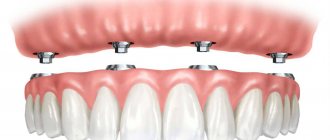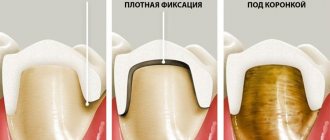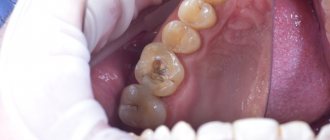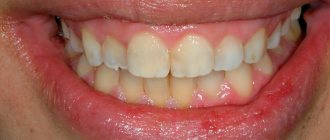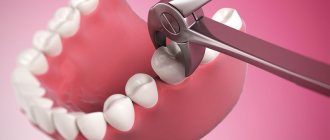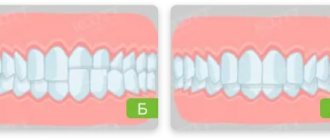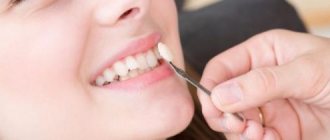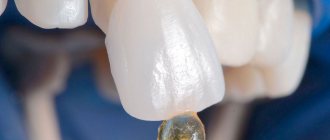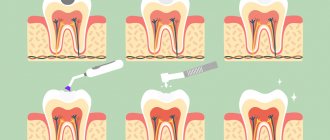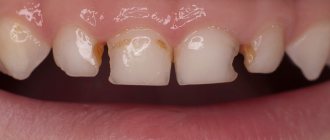Naturally beautiful smiles are a modern trend. The ViDentis family clinic will help you correct aesthetic deficiencies in the dentition in the frontal area and become the owner of beautiful front teeth. We offer installation of high quality ceramic veneers on teeth. Just a few visits to our orthopedic dentist and you will become the owner of the most attractive smile.
What are veneers for front teeth?
Veneers are thin (up to 0.7 mm) onlay plates that are attached to the front teeth from the outside. These orthopedic structures are of the non-removable type, that is, after installation only a dentist can remove them. You need to wear veneers for the rest of your life, since fixing them requires dental treatment—removal of a thin (up to 0.7 mm) layer of tooth enamel. We can offer an alternative - very thin linings, the thickness of which does not exceed 0.3 mm. These are veneers without grinding, for which you do not need to prepare the tooth.
Instructions for use
In addition to the installation instructions, it is necessary to take into account the manufacturer's instructions for using the Perfect Smile Veneers design. It is important to store the product correctly and promptly clean it from food residues.
Basic rules when using Perfect Smile Veneers:
- The pads must be stored in a special container included with the product;
- The plates should be washed regularly for cleaning and disinfection;
- It is better to soften the veneers and give them shape immediately before installation;
- It is not recommended to attempt to use the pads for purposes other than their intended purpose;
- The plates must not be broken, bent or subjected to other traumatic effects.
When used correctly, Perfect Smile Veneers can last for many years and will not require immediate replacement.
You can wear veneers throughout the day, but at night it is recommended to remove them and wash them.
The product should be washed according to the manufacturer's instructions:
- Perfect Smile Veneers can only be washed in warm water;
- It is not recommended to use soap substances intended for hair and body;
- You should not use devices with solid particles, for example, scrubs, toothbrushes, especially with hard bristles;
- Avoid using chemicals;
- It is better to rinse the plates under running water;
- The product should dry naturally.
The best way to clean veneers is to use warm water and baking soda; you can also use toothpaste or powder, but apply them with your finger. After the procedure, the plates should be lightly blotted with a towel and left to dry in a well-ventilated area.
Ceramic veneers
Several years ago, the disadvantage of dental ceramics was fragility. The latest generation of ceramic materials used in ViDentis dentistry is durable and reliable. Pressed glass ceramics are reinforced with leucite crystals, due to which the veneers can withstand heavy loads. For jewelry-accurate restorations, we use E-max veneers - these are ultra-thin onlays (0.1-0.3 mm) that are installed without treating the teeth.
Ceramic structures are made exclusively in laboratory conditions according to individual casts of a particular patient. Dentistry "ViDentis" has its own dental laboratory, so for our patients the manufacturing process takes a minimum of time.
Materials
Veneers are made from different materials, with ceramic and composite materials being the most popular.
The choice of material is one of the most important stages in the manufacture of veneers.
Modern composite materials are used to manufacture structures using the direct method.
In this case, it is best to give preference to materials that are the most reliable: not subject to abrasion, color-fast, have a wide range of colors, and are well polished.
Indications
The installation of veneers is carried out to achieve maximum aesthetics of the dentition in the smile area and solves a number of problems:
- slight unevenness in the shape of the teeth;
- restoration of teeth with small cracks and chips in the enamel;
- wide or narrow interdental spaces;
- teeth too short;
- changes in enamel shade that cannot be corrected by whitening.
Contraindications include the risk of damage to the front teeth due to sports or professional activities. We will temporarily postpone the installation of veneers on teeth if the patient’s bite is significantly compromised. In this case, we will first suggest orthodontic treatment with braces or mouth guards.
If the patient has caries or large fillings on the front teeth, the possibility of installing veneers is considered individually. In some cases, carious cavities and fillings can make it impossible.
Casting method (injection pressing)
With this technology, a wax overlay of the required shape is made onto a plaster tooth model, which is then treated with a glass-ceramic solution and packed into a special fire-resistant mass.
- Under the influence of high temperatures, the wax melts and is burned out in a vacuum.
- The resulting plate is painted in a color that fully matches the color of the enamel and sanded.
This method is simple to implement and allows you to obtain a highly durable prosthesis and an excellent aesthetic effect.
Advantages
- Restoring teeth with veneers allows you to get a beautiful smile in a short time and for many years.
- The material’s physical properties are as similar as possible to natural tooth enamel, so teeth with veneers look absolutely natural.
- You can choose the shade of the structures exactly to match the color of the patient’s teeth.
- Veneers fit perfectly to the gum, forming an attractive gum line
- Ceramic linings retain their color, transparency and shine for many years and are not affected by food coloring.
- Veneers reliably protect teeth from caries and reduce their sensitivity to cold/hot.
- The service life of linings made of high-quality imported glass ceramics that we install is up to 15 years.
Working impression and occlusion determination
When making a veneer in a laboratory in a clinic, it is necessary to take an impression from the dentition, including the prepared tooth, an auxiliary impression from the antagonist dentition, and determine the patient’s usual occlusion.
Precision polyvinylsiloxane (silicon-A) materials are best suited for the working impression. For preparations with a shoulder at or below the gingival level, gingival retraction is performed and a two-layer impression is obtained using a one-step or two-step technique, depending on preference.
For an auxiliary impression, alginate mass is used. And to register occlusion, special silicones are used again. The advantage of these special materials over waxes is that they are more rigid and allow the application of registration material after closure of the dentition and control of occlusion. The base layer of the impression mass, as well as the base wax, are not suitable for recording occlusion, since they are not rigid enough and can lead to significant errors.
Who installs veneers at ViDentis dentistry?
Professional, polite and attentive doctors work with patients. Our orthopedic dentists have extensive practice and deep knowledge of modern materials and technologies for veneering (veneer installation). The clinic has specialists who deal specifically with this problem, have an artistic approach and a high understanding of the aesthetics of this process.
But despite this, ViDentis specialists regularly attend trainings and seminars of leading experts in this field. They have dozens of successful smiles and satisfied clients behind them.
Varieties
Onlays can be made of composite material or medical porcelain and zirconium. Porcelain products are more durable, but more expensive. Composite structures will last from three to five years, then they should be replaced with new ones. The advantages of composite veneers include price and ease of removal/installation. Componeers (composite plates) require more careful care and regular visits to the dentist to coat the surface with a special varnish.
The most reliable are zirconium linings; they can last more than twenty years. However, they do not look natural; this is noticeable to the naked eye. The artificiality of zirconium overlays is explained by the lack of light conductivity. Another disadvantage is the need for strong grinding of the enamel before installing them.
However, the biggest disadvantage of installing overlays made of any material is the loss of part of the enamel layer.
Lumineers
These overlays are called Hollywood and differ from ordinary veneers in their thinness. They are made from transparent porcelain and attached using a special adhesive.
Lumineers are highly durable and can last up to twenty years with proper care. Do not stain when eaten. However, Lumineers are not suitable for everyone. Lumineers are so transparent that they cannot mask stains or yellowness of the enamel layer.
There is another significant drawback of lumineers - when removing the plates, the enamel coating is inevitably destroyed. This is due to the peculiarity of the cementing composition on which the linings are attached: it is too strong.
Removable veneers perfect smile
This prosthesis imitates the gums and upper teeth. Used in emergency cases when a beautiful smile is needed. This is an invention of American orthodontists. The prosthesis provides a snow-white smile without preliminary grinding of the enamel and a visit to the dentist’s office.
How to use removable perfect smile veneers? It's very easy to do. Before the first fitting, the prosthesis should be placed in a glass of boiling water for several minutes so that the material becomes pliable. Then the denture is removed and applied to the upper teeth, holding it with your hand for 1-2 minutes. During this time, the material of the product will take its shape and remember its location. For subsequent uses, do not place the prosthesis in boiling water.
How often can you wear a perfect smile? The prosthesis is worn any time a charming smile is needed. How long can I wear a prosthesis? You can wear your perfect smile all day long, but before going to bed you need to remove it and wash it. Wash the denture with plain water and periodically clean it with mouthwash.
Ultraneers
Ultraneers are made from pressed ceramic chips. The advantages of onlays include quick adaptation, since the patient practically does not feel the foreign body in the mouth. The products look natural and are indistinguishable from real teeth. Lumineers are manufactured in the USA, so the cost of installation is always very high. Ultraneers are three times cheaper, since they are produced in Russia.
However, installation of ultraneers sometimes requires grinding of the enamel. The quality of ultraneers is inferior to lumineers in many respects, but they are cheaper. Ultraneers are also an alternative to aggressive whitening, as they protect the enamel from thinning.
Ultraneers are installed in two visits to the orthodontist’s office: during the first visit, an impression of the jaw is made, and on the second, onlays are installed. Ultraneers are easily removable and can be replaced with ceramic or zirconium veneers.
Veneering procedure
Preparation
The oral cavity must be absolutely free of infection to prevent the development of caries under the veneers. Therefore, before the procedure, each patient must undergo professional teeth cleaning to remove tartar and, if necessary, caries treatment.
Enamel processing
To prevent the veneers from sticking out after fixation and the teeth themselves not to look huge, the doctor removes a thin layer of enamel from their outer side, equal in thickness to the future veneers. If veneers are placed without turning - ultra-thin, enamel preparation is not required.
Manufacturing
The orthopedist will take impressions of the treated teeth, from which the laboratory will first make veneers for fitting, so that the patient can be convinced that his new smile is perfect. After the client approves the shape, size, and shade, the laboratory will begin manufacturing permanent structures. The process lasts several days. Of course, the patient does not walk around with his teeth ground during this time - the doctor fixes temporary veneers on them.
Installation
When the pads are ready, the patient is invited for installation. The orthopedist treats the surface of the teeth and veneers with special compounds, then firmly fixes them with dental cement and polishes them.
Layer-by-layer method
In this method, plates are made from platinum foil, whose thickness is 0.020-0.025 millimeters.
The foil is pressed around the prepared tooth on a plaster model. The specialist applies ceramic mass to the model and fires it. The foil holds the ceramics during the firing process, which prevents possible distortion and loss of the desired shape. The model is then sanded and finishing touches are made so that the veneer can be seated on the intended tooth without any problems. This technique is economical because it does not require the use of expensive platinum foil. Therefore, manufacturing the structure will not cost a lot of money.
How much does it cost to get veneers on front teeth?
The final price of dental veneers depends on their quantity, the material for their manufacture and the complexity of the clinical case. In our clinic, the cost of an all-ceramic veneer for 1 tooth is 22,000–25,000 rubles, and an E-max veneer is 30,000–35,000 rubles.
Tags: installation of veneers on teeth, cost of veneers on teeth, veneers for 1 tooth, cost of a veneer for 1 tooth, price of a veneer for 1 tooth, installation of veneers on teeth, veneers on front teeth price, putting veneers on teeth price, how much do veneers cost front teeth, price of veneers on teeth, how much does it cost to put veneers on teeth, veneers on front teeth cost, cost of veneers on front teeth, installation of veneers on teeth price, installation of veneers on front teeth price, installation of veneers on front teeth price, restoration of teeth with veneers , installation of veneers on teeth cost, how much does it cost to install veneers on teeth
Bottom line
Perfect smile veneers are an imitation of the upper row of teeth along with the gums, thanks to which you can not be afraid to smile openly and joke. The perfect smile removable denture does not require a visit to the orthodontist or preliminary teeth grinding. To get a snow-white smile, you just need to put the denture on the upper jaw and hold it lightly until it takes the anatomical shape of your teeth. However, the perfect smile has a drawback: the lack of imitation of the lower jaw.
To correct small defects in the dentition, you can purchase lumineers: their installation does not require grinding of the enamel. If there are significant defects in the dentition, lumineers will not help, as they are made of completely transparent material. To correct large defects, ceramic onlays or plates made of composite material are required.
Sources used:
- The National Center for Biotechnology Information (USA)
- Proffitt U.R., Modern orthodontics (3rd edition), MEDpress-inform, 2015, 560 p.
- “Orthopedic treatment with fixed prostheses” (Rozenstiel S.F.)
Prices
| Consultation | |
| Initial dental consultation and treatment plan | 500 rub. |
| Veneers | |
| Composite restoration veneer “Esthet-X” | from 8,500 rub. |
| Ceramic veneer EMAKH | from 25,000 19,900 rub. |
| Temporary veneers | 3,500 rub. |
| Diagnostics | |
| X-ray of teeth | 300 rub. |
| Sight shot of teeth | 300 rub. |
| Panoramic photograph of teeth (orthopantomogram) | 1,000 rub. |
| Anesthesia | |
| Infiltration anesthesia | 450 rub. |
| Conduction anesthesia | 600 rub. |
Contraindications
Contraindications are the same as for conventional veneers:
- diseases of the teeth and gums (caries, pulpitis or periodontitis);
- significant bite defects;
- bruxism - involuntary grinding of teeth during sleep;
- tooth mobility;
- significant destruction of the crown of the tooth.
